
If you're a gardener in Southern California, you know only too well the feeding signs of the notorious brassica-loving cabbage worm. These common pests, while pretty to look at in their adult form, can quickly destroy your hard-earned winter crops, so it's important to take control of them as soon as possible. But don't worry; there are several ways to get rid of cabbage worms without resorting to harsh chemicals.
Keep reading to learn about ten ways to help you get rid of the cabbage white caterpillar and even the adult butterflies. Some methods are a bit more hands-on (quite literally), while others may be utilizing cabbage worm predators, using certain sprays to keep the cabbage worms away, or simply covering your crops. Whatever route you choose, you can be sure to find something that works for you and your garden below.
What are Cabbage Moths and Cabbage Worms?
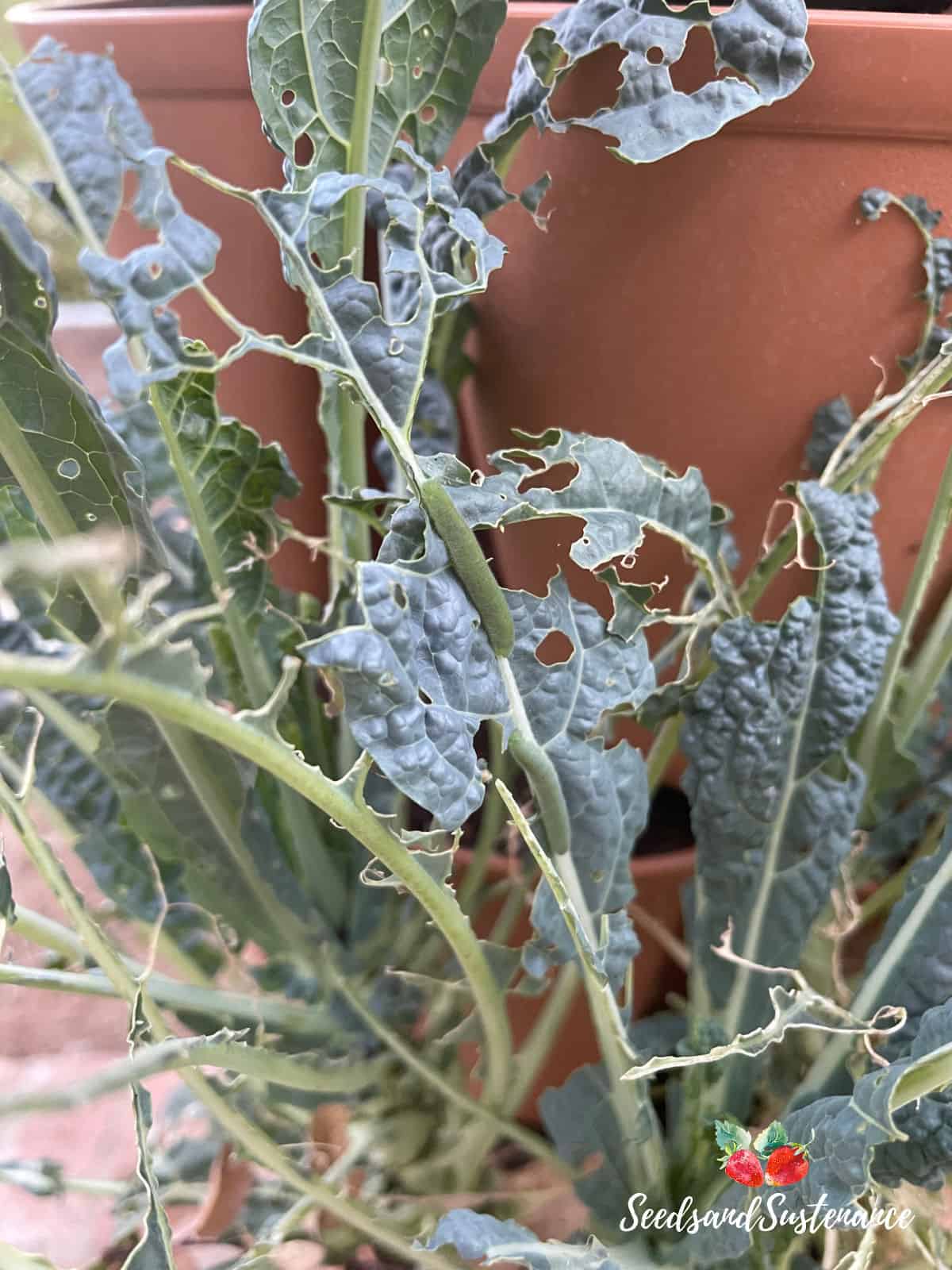
Cabbage worms are the larvae of the white butterfly, and they love to feast on brassica plants like cabbage, broccoli, cauliflower, bok choi, and kale. These little green caterpillars can decimate a crop in no time flat, which is why the sooner you take care of them, the better.
Cabbage moths (which are actually butterflies) are small, white butterflies that lay their eggs on the underside of the leaves of cabbages, broccoli, kale, brussels sprouts, turnip greens, mustard greens, and collards - to name a few.
These are often seen flitting around the garden and may seem quite nice to look at until you spot them laying eggs in the garden.

The caterpillars that hatch from these eggs are called cabbage worms. They are bright green with white stripes running down their backs, and they eat holes in the leaves of cabbages and other crucifers. Cabbage white butterflies are most active in late summer and early fall. Green cabbage worms are also the most active during this time of year.
Cabbage loopers are a caterpillar that actually does come from a brownish-colored nocturnal moth. These pests are also attracted to members of the cabbage and mustard family. These caterpillars can be distinguished from others by the way they move - inching along like an accordion instead of crawling like other caterpillars.
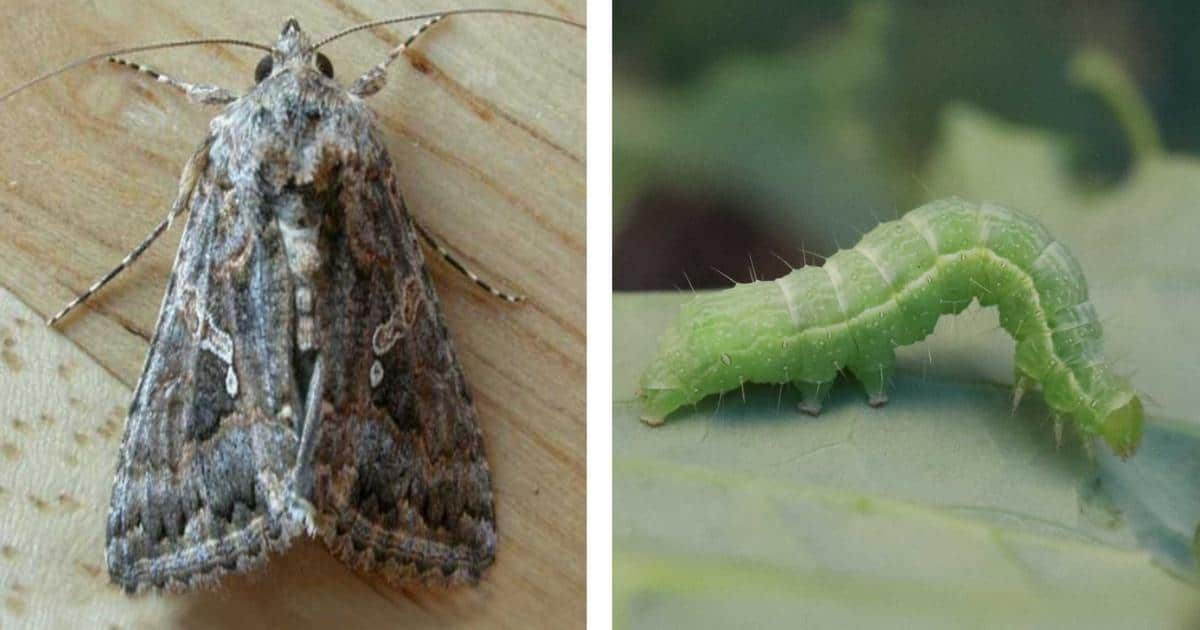
Regardless of which pests reside in your garden, they can damage your broccoli, kale, and brussels sprouts, as well as your cabbage heads. Just one patch of cabbageworm eggs is all it takes to start an infestation.
To prevent them from devouring everything, you can use a variety of methods, including covering your plants with netting or using insecticidal soap.
Types of Cabbage Worms and Cabbage Butterflies - Imported Cabbage Worm, Cabbage White, and Cross-Striped
There are two types of cabbage worms, both of which are green in their larval form that turn into the white butterflies we're so familiar with.
Here's how to identify cabbage worms in the garden:
Pieris rapae
Pieris rapae, more commonly known as the "imported cabbage worm," is the smaller of the two types of cabbage worm you can find destroying brassica crops like broccoli, kale, bok choi, cauliflower, brussel sprouts, collard greens, and other plants in the cabbage family.
Its origins can be traced to 1860, when it was first observed in Quebec City, Canada. In the following years, it rapidly spread as far south as the Rocky Mountains. Some say the imported cabbage worm originated in the Eastern Mediterranean region of Europe.
Nowadays, Pieris rapae is widespread throughout North America, Asia, Australia, Europe, New Zealand, North Africa, and South America, thanks to the diversification of cruciferous crops and the development of human trade routes. This led to the accidental introduction of this common garden pest - hence the name "imported cabbageworm".
The imported cabbage worm turns into a small, white adult cabbage butterfly with black markings on the tips of its wings. The front wings are also marked with black dots, two for females and one dot for males.
Pieris brassicae
Also called the "large white," "cabbage white," "cabbage butterfly," and "cabbage moth" (erroneously), Pieris brassicae can be found in temperate areas of Europe, North Africa, South Africa, and Asia, even as far as the Himalayas. It is a close relative of the "small white", Pieris rapae, though much larger in size.

In 2010, it was discovered to have "migrated" to New Zealand and is known there as the "great white butterfly." In 2014, with the help of the public and the release of predatory wasps, this unwanted pest was eradicated from the island.
Pieris brassicae is a large white butterfly with black markings on the tips of its forewings. The females have two black spots on the forewings, whereas the males do not.
Evergestis rimosalis
The third type of cabbage worm known as Evergestis rimosalis, or the "cross striped cabbage worm," is found in the Eastern United States - at least, for now.

With continuously warmer temperatures and unpredictable storms, this third type of brassica pest quite literally gets blown into new areas to wreak havoc on cabbage family crops. so, while we may not see this particular cabbage worm in Southern California, it may only be a matter of time before it becomes commonplace.
The Forewings of adult cross-striped cabbage worms are straw-colored with olive to purplish-brown markings and transverse lines and hindwings are whitish with a dark margin.
The method for controlling cabbage moths or cabbage loopers is the same regardless of which pest you have in the garden.
Similar Pests
There are several other Lepidopteran insects in the cabbage worm category:
- Cabbage moth (Mamestra brassicae)
- Cabbage webworm (Hellula undalis)
- Orange tip butterfly (Anthocharis cardamines)
- Diamondback moth (Plutella xylostella/Plutella maculipennis)
These cabbage moths and butterflies are also attracted to the presence of cabbage and other members of the brassica family.
Where Do Cabbage Worms Come From?
You know those cute little white butterflies you see dancing around the garden? The ones you thought were so cute? Perhaps, like me, you even felt excited at one point when you saw them.
Yeah, those are the butterflies you DON'T want to see. These innocent-looking butterflies are the bane of all cruciferous veggies since they are the worms that eat everything in that family, so keep a close eye out when August-November starts to roll in in zones 9 and 10.
Cabbage worms are the larvae of the cabbage moth, and if you see those, chances are you will see cabbage worms in your garden if you look closely enough. The adult moths are attracted to members of the cabbage and mustard family and lay their eggs on the undersides of the leaves.
When the eggs hatch, the larvae (cabbage worms) start to eat the leaves of these vegetables and can easily decimate a garden if left unchecked.
If you notice missing leaves and holes eaten through the remaining leaves on your brassicas, chances are, you will find cabbage worms and perhaps even some tiny cabbage moth eggs on the underside of a leaf.
You can often see cabbage white butterflies flitting around the garden during the day.
How to Identify Cabbage Worms - What do Cabbage Worms Look Like?
Pieris rapae, also known as imported cabbage worms, are most commonly found here in Southern California. They are green in color with a velvety feel and appearance. It has five pairs of prolegs and exhibits a narrow yellow line down its back, which can sometimes be a broken yellow line or series of yellow dots.
Pieris brassicae, the cabbage worm most commonly found in Europe, is light yellow with a distinctive brown head and dark speckling on either side of its back.
Evergestis rimosalis, or the cross-striped cabbageworm, has a blue-grey back with transverse black stripes, hence the name "cross-striped."
What do cabbage loopers look like?
Trichoplusia ni, otherwise known as the cabbage looper, is a medium-sized moth often referred to as the owlet moth. The larvae are green in color, just like cabbage worms but are thinner and "loop" when they arch their backs and inch along.
Cabbage Worm Life Cycle & Cabbage Worm Damage
Cabbage worm life cycles vary depending on the species of moth, but most go through four stages: egg, larva (caterpillar), pupa, and adult. The time from egg to adult can take as little as two weeks or as long as eight weeks.
Adult females lay their eggs on the underside of plants in the brassica family, which provide an excellent source of food their larvae.
When the eggs hatch, green, velvety little caterpillars emerge and immediately begin feeding. Their legs are so tiny at this stage that they look more like worms than caterpillars, hence the name "cabbage worm."
These little worms progress through five larval phases, or instars, where they go through coloration changes, becoming a lighter, more solid green every time they molt.
Once fully grown, the caterpillars form a chrysalis, or pupa, from which they eventually emerge as adult butterflies.
For most gardeners, the life cycle begins when you see the first few white butterflies dancing in the garden, flitting from one plant to the next.
If you look closely, you might notice that each time a female cabbage moth gets near a cabbage head, brussel sprout, or broccoli leaf, they tap their butts on the underside of the leaves. Each time they do this (which is about 10-20 times per day), they deposit a single egg.
Multiply that by potentially dozens of female cabbage moths, and you've got yourself an infestation waiting to happen. A cabbage worm infestation can occur very quickly since these butterflies are extremely active during daylight hours, moving from crop to crop in rapid succession.
That's why it's important to keep the cabbage worms from eating your plants in the first place; you can either squish the eggs as you find them, remove the caterpillars by hand, or repel cabbage moths with strategic interplanting - this works well for cabbage worm control since they don't like certain plants like thyme, marigold, tomatoes, tansy, and peppermint.
Adult imported cabbage butterflies (the ones most common here in Southern California) can live up to three weeks, and the females can lay 300-400 eggs during this time.
The eggs of the cabbage moth are oblong and yellow or whitish in color and are almost always attached to the underside of leaves. The eggs are always laid sporadically and never in clumps or groups. If you find clusters of oblong eggs that are yellowish in color, you're probably looking at ladybug eggs - don't squish those!
When the caterpillar eggs hatch, the larvae immediately begin to feed on the surrounding plant matter, which can be seen as various-sized holes in the leaves to completely demolished leaves. I've had entire kale plants look like straggly sticks after just a few weeks.

Most large healthy plants will be able to pull through with only cosmetic damage. However, seedlings and otherwise stressed or leggy plants can very easily get killed - which is devastating because brassicas take a long time to grow and the optimal window for planting them is short due to waning daylight hours.
As the caterpillars continue to feed and grow, they will form a chrysalis, where they will transform into adult cabbage white butterflies.
Signs of Cabbage Worm Infestation
Cabbage worms are one of the most destructive pests in the fall and winter garden.
If you see a cabbage worm around your garden or on your crucifers, then you have a cabbage worm problem, plain and simple.
These small, green caterpillars are most likely the larvae of cabbage white butterflies, and they love to eat cabbage leaves and other brassica plants that contain glucosinolates or glucosides.
In fact, they can strip a cabbage bare in just a few days! Cabbage worms also lay their eggs on other cruciferous vegetables, so you may see small, white to yellowish eggs on the undersides of leaves. And, if you see small, spherical black poop on the leaves of your cabbages, that's another sign that cabbage worms are present.
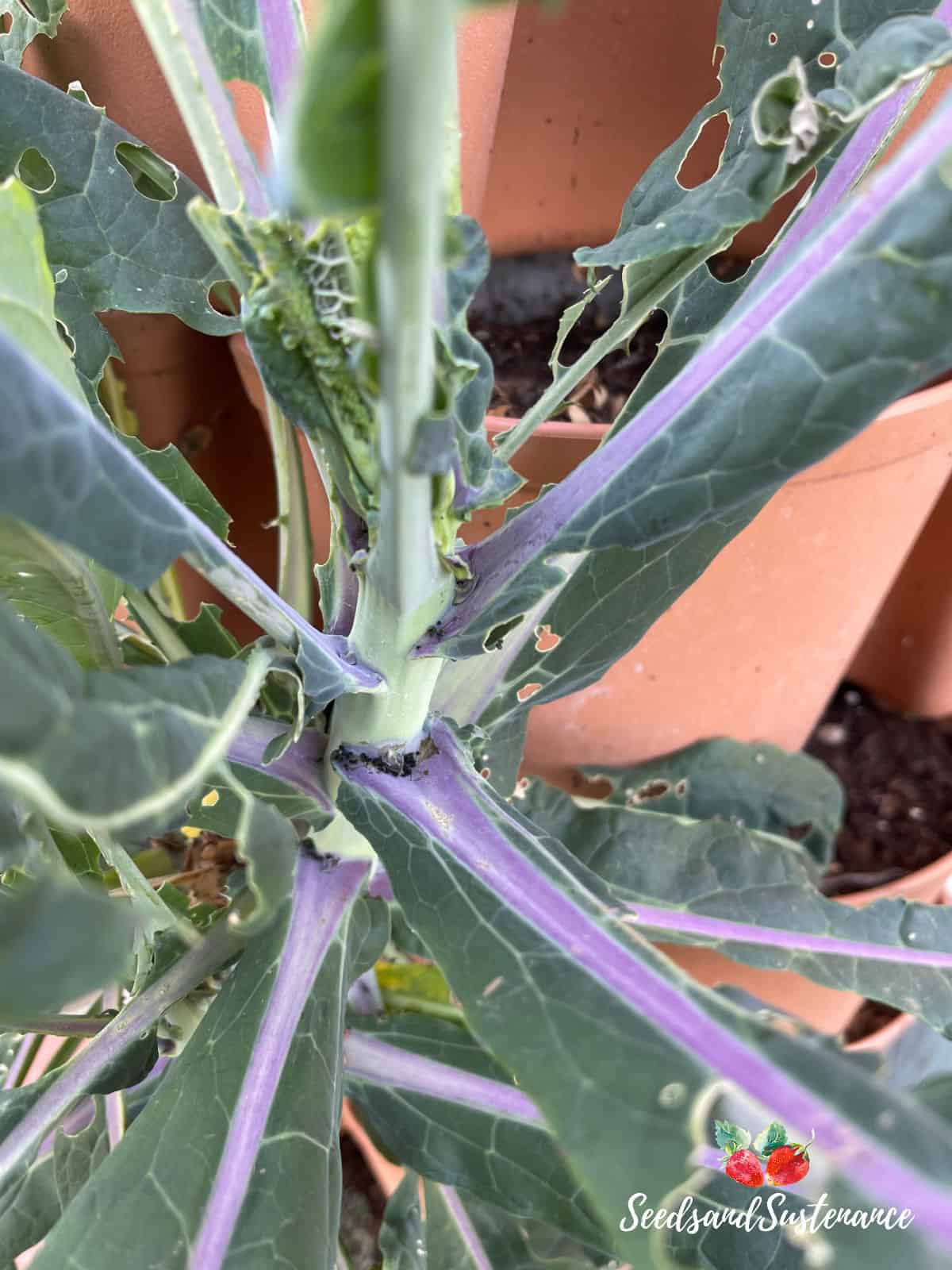
Cabbage worms also prefer the following brassicas:
- Arugula
- Bok choi
- bomdong
- Broccoli
- Broccoli rabe
- Broccoli romanesco
- Brussel sprouts
- Cabbage
- Cauliflower
- Cime di rapa
- Choy sum
- Collard greens
- Daikon radish
- Gai lan
- Garden cress
- Kale
- Komatsuna
- Mizuna
- Mustard greens
- Napa cabbage
- Radishes and radish greens
- Rutabaga and rutabaga greens
- Savoy cabbage
- Tatsoi
- Turnips and turnip greens
- Wasabi
- Watercress
Though far less common, cabbage worms will also eat:
- Lettuce
- Spinach
- Tomato plants
- Various flowers
As far as garden damage is concerned, here is a common scenario:
Let's say you plant an entire garden bed with beautiful plants in the Brassicaceae family, and one day you come outside to look things over, only to find tiny holes in most of the leaves.
Upon further inspection, you see tiny spherical green-brown or black droppings at the base of some of these plants or on the untouched leaves beneath eaten ones.
If you look more closely, following the path of droppings, you might find your culprit - a green cabbage worm feasting away on your precious cauliflower!
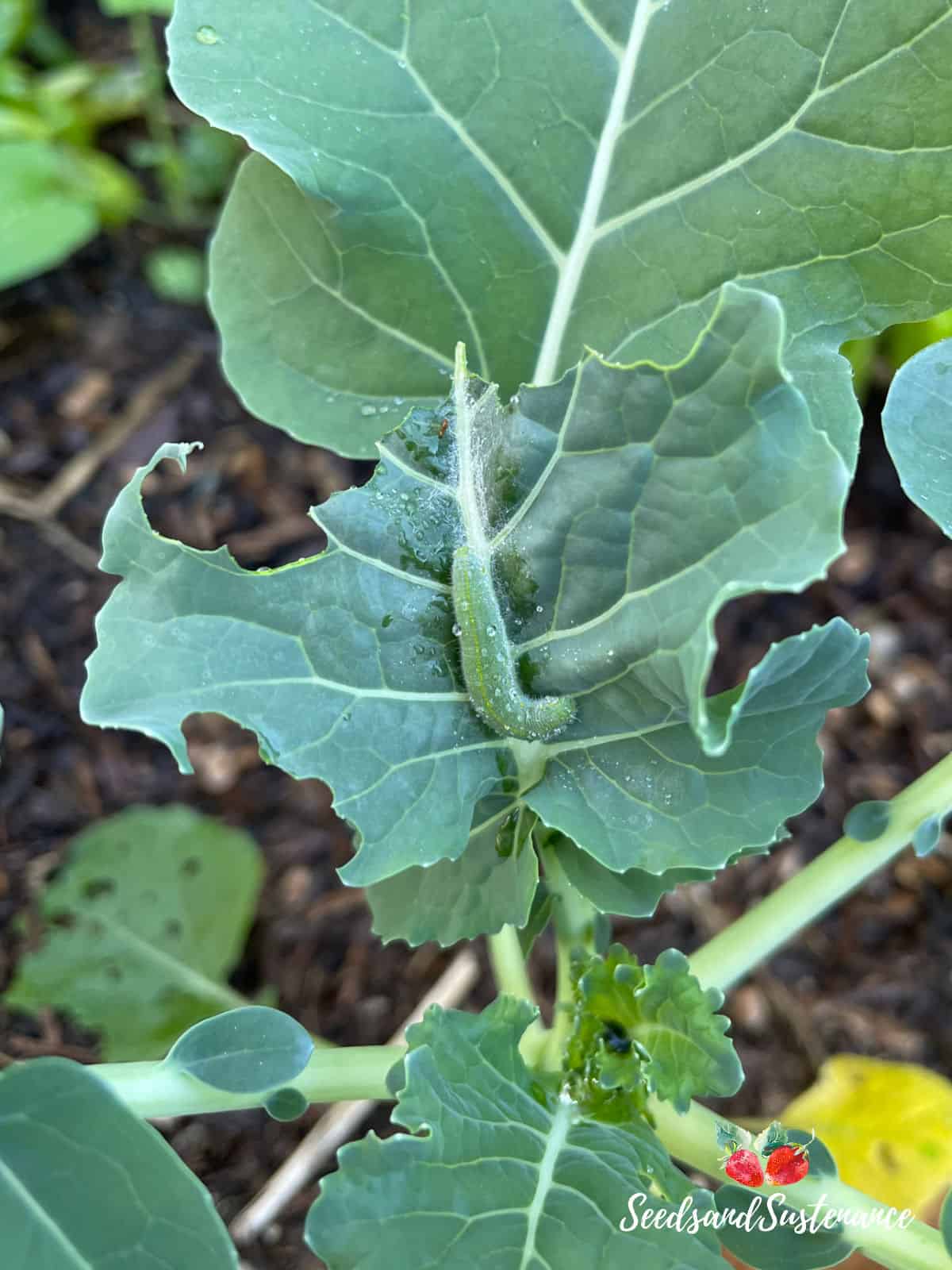
As soon as you find one, you can be certain that there are many others (remember, a single female can lay up to 20 eggs per day). Without intervention, these worms will kill the cabbage and cauliflower you spent so much time nurturing over the past few months.
Finding a few holes in your plants is one thing; finding absolutely decimated plants is quite another. In either case, both indicate a cabbageworm problem that needs to be taken care of immediately.
To prevent cabbage worm damage, follow the steps outlined below.
How To Get Rid Of Cabbage Worms Organically on Broccoli, Kale, Brussels Sprouts & More
Now that you're able to identify the various cabbage worms and cabbage loopers in your garden let's get into how you can eradicate these pests from your organic garden using natural methods.
- Manual Removal
- Introduce Natural Enemies/Beneficial Insects
- Bacillus Thuringiensis (Bt or BtK) Spray
- Plant Trap Crops to Attract Cabbage Worms Mostly to Those Areas
- Floating Row Covers
- Use Companion Planting to Deter Cabbage Worms
- Plant Purple & Red Varieties
- Use Neem Oil
- Make Decoy Moths to Place Around the Garden
- Use Diatomaceous Earth
The best products you can buy for getting rid of cabbage worms:
- Bonide Bt Liquid Concentrate
- Monterey Bt treatment Liquid Concentrate
- Monterey Bt ready to Use Spray
- Bonide Captain Jack's Dead Bug Brew (Spinosad) Liquid Concentrate
- Harris Diatomaceous Earth powder with Duster Applicator
1. Remove the Caterpillars and Eggs by Hand to Get Rid of Cabbage Worms Naturally
In order to remove these pests, you need to know how to find them and where to look.
- Carefully inspect the underside of the leaves
- Check new growth in the center of the plant - cabbage worms love to hide here
- Look at the stems of kale plants - the caterpillars are often well disguised here!
- Look for "frass" or cabbage worm poop, as this indicates that a caterpillar is nearby
- Look for leaves with holes - especially holes in cabbage leaves
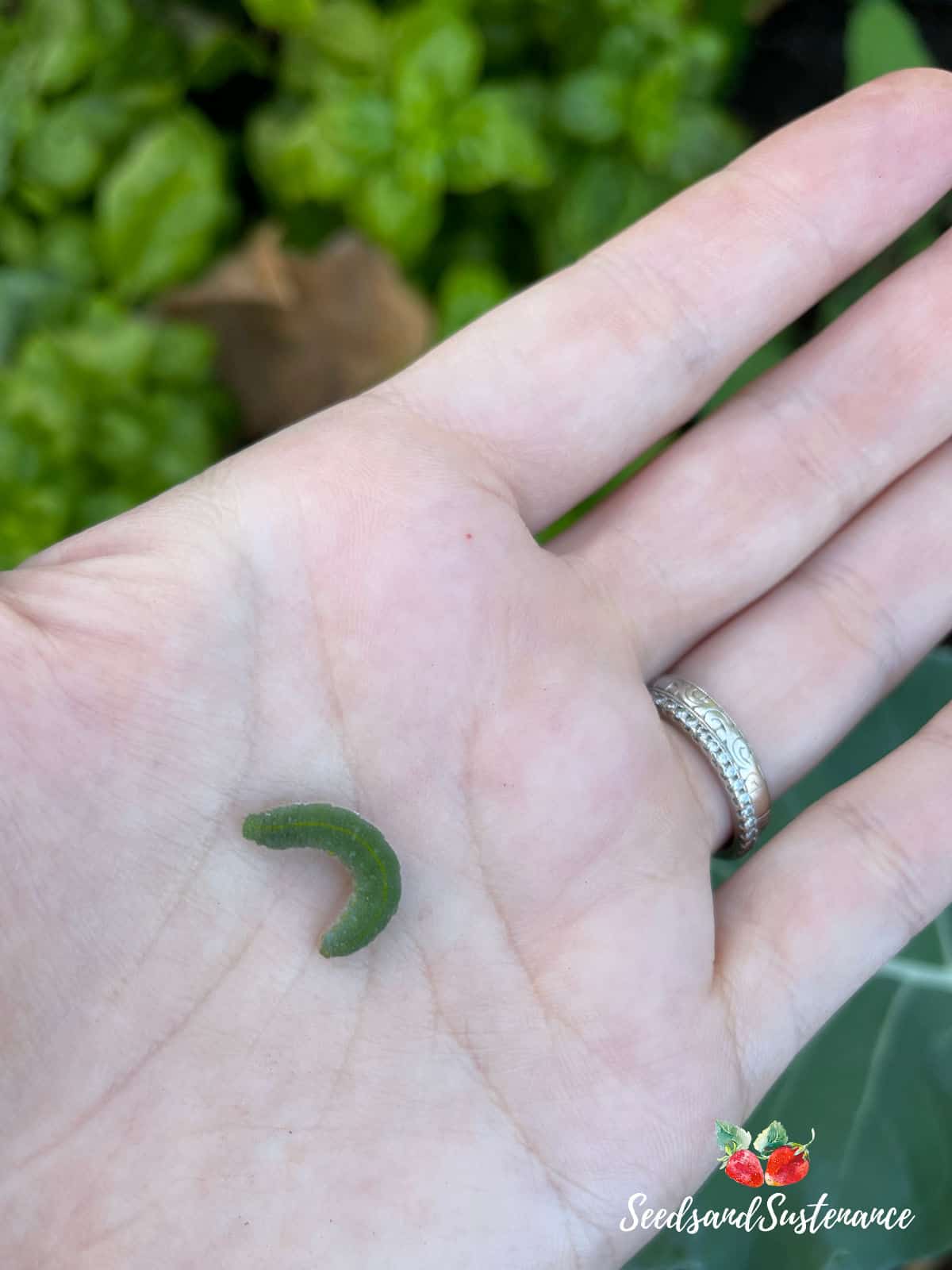
Once you have found the offending cabbage worms, there are a few ways to control them, as discussed below.
One method (and perhaps the easiest!) to lessen cabbageworm damage is to pick the caterpillars off by hand and drop them into a bucket of soapy water. This is time-consuming (it needs to be done once a week minimum) but very effective.
If throwing the caterpillars into soapy water seems like a waste, consider feeding them to your chickens or putting them out on a tray for the birds who enjoy cabbage worms.
And, if you're a bit squeamish about touching insects with your bare hands, I suggest wearing gardening gloves, even the thin cloth kind, for easy maneuverability. You can also try using a stick or other tool to knock them off into a bucket, but I find this method to be really hit or miss since the caterpillars like to stay on the underside of leaves or safely tucked away in other places that are out of sight of birds.
As for the eggs, it's a good idea to check the leaves of your brassica plants about once a week. Once you find an egg, you can squish it with your gloved finger or try to brush it off into a bucket of soapy water. Don't just brush off the eggs without disposing of them first since they will still hatch as long as they are undamaged and may travel back to your plants.
Another interesting method for eradicating cabbage moth populations is to use a butterfly net to capture the adults as they fly around the garden. You can then toss them into some soapy water or feed them to the chickens (as long as the butterflies can't fly away).
To make manual removal effective, you need to inspect your brassicas frequently; otherwise, it's a losing battle that can quickly get out of control as the cabbage worms multiply.
2. Introduce or Attract Natural Enemies/Beneficial Insects to Kill Cabbage Worms
Another common yet efficacious way to control cabbage worms is by introducing their natural enemies into the garden. Ladybugs, lacewings, and parasitic wasps are all great options for reducing cabbage worm populations. You can easily purchase these beneficial insects from your local nursery or garden center - even online!
Of these three options, parasitic wasps are going to be the most effective. They lay their eggs on top of (and sometimes inside) the cabbage worms. When the eggs hatch, the wasp larvae eat the host caterpillar from within and kill it. This method can really help keep the cabbage worms under control.
However, parasitic wasps will often lay their eggs on other types of caterpillars and even inside the chrysalis of other caterpillar species, including that of the monarch butterfly so use these beneficial insects with caution.
If you want to attract parasitic wasps to your garden without purchasing them, you can plant umbrella-shaped flowers like:
- Allium
- Alyssum
- Cosmos
- Dill
- Fennel
- Queen Anne's lace
- Statice
- Thyme
- Yarrow
- Zinnias
Adult wasps feed on nectar and pollen and will be attracted to these flowers.
Here are a few more of the cabbage worm's natural enemies:
- Birds - sparrow, skylark, scrub jay, etc.
- Parasitic flies
- Predatory beetles
- Spiders
- Yellow jackets
3. Use Bacillus Thuringiensis (Bt) Spray to Prevent Cabbage Worm Damage
My personal favorite and one of the most effective ways to get rid of cabbage worms, especially if you're short on time, is to use a bacterial spray known as Bt. It's easy, saves time, and works. Plus, it's still one of the best organic ways to get rid of these destructive pests.
Bacillus Thuringiensis is a naturally occurring, soil-dwelling bacteria that is toxic to caterpillars. When ingested, it produces a crystal-shaped protein that essentially starves the caterpillar by making it stop eating. Bt works not only on cabbage white worms and cabbage loopers but also on hornworms and other pests.
However, keep in mind that it will also kill the caterpillars of monarch butterflies and other caterpillar species, so make sure to use Bt with care.
Bt is considered safe even if consumed by humans on the same day of harvest.
There are several varieties of Bacillus thuringiensis (Bt) that are effective against cabbage worms. These bacteria occur naturally in the soil and on leaves and are deadly to caterpillars when ingested but not harmful to animals, humans, or other insects besides caterpillars. Bt can be applied as a spray and is available at most garden centers.
You can get a pre-mixed version or a concentrate, which is more cost-effective.
You can get the Bt concentrate I use HERE.
How to Use Bt in the Garden
Bt is a great tool against cabbage worms and is quite possibly one of the easiest to use.
When using a pre-made spray of Bt, it's as easy as going out to the garden and spraying your plants.
If you picked up the concentrate version, dilute it according to the instructions on the label.
I prefer to use the concentrate not only because it saves money but also because I can easily use a sprayer of my choosing. I like to use this simple hand pump sprayer. The nozzle is long enough to help get the Bt on the underside of leaves and in other hard-to-reach areas where caterpillars like to hide.
I recommend applying Bt in the evening as it rapidly degrades in sunlight. If you must use it during daylight hours, rest assured that it is a gentle form of pest control and will not burn your plants in the sunlight like other sprays.
Bt washes off very easily, so be sure to check the forecast for rain and avoid using it when your sprinklers are scheduled to water the garden (if you use overhead watering techniques). If your garden needs to be watered, consider doing a good deep watering the night or early morning before application.
Bt is most effective a few days after application. After that, it rapidly degrades to practically nonexistent by day 7.
Lastly, Bt is most effective on younger, smaller caterpillars, so be sure to use it as soon as you start seeing worms smaller than 1 inch. For some reason, Bt doesn't work as well on larger caterpillars.
Even so, be sure not to spray Bt anywhere near milkweed or other food sources of beneficial butterflies.
4. Plant Trap Crops to Attract Cabbage Worms and Cabbage Moths
Organic gardeners may also want to try planting trap crops such as nasturtiums and mustard greens around their brassica plants. These plants will attract the cabbage worms, which can easily be picked off and destroyed before they have a chance to damage the main crop.
You can plant these around the perimeter of your cruciferous veggies to attract the attention of the white butterfly to the trap crops first. This can help reduce the number of eggs on your actual main crop.
To keep the trap crops going strong, be sure to succession sow them every few weeks during the months of August through November. Remove any particularly infested nasturtiums to prevent an explosion of new adult butterflies.
And don't forget the mustard! I have found that planting mustard near your cabbage can really help keep the worms off those precious heads.
Since I live in Zone 10, I often keep a few nasturtiums dotted around my garden all year round for this very reason. Not only do they attract cabbage moths, they also attract aphids.
5. Use Row Cover to Protect Your Brassicas - An Easy Cabbage Worm Control Method
Using row covers in the garden is one of the best and most organic methods you can use to prevent adult cabbage white butterflies from even laying eggs on your brassicas.
They literally have zero access to your plants! However, they will also keep beneficial pollinators from getting to your plants as well, so keep that in mind if you're using row covers on varieties that need pollination to produce fruit.
Row covers are a great tool to use in your garden for pest control. They act as a physical barrier between cabbage worms and your plants, making it difficult for them to land on or feed off the plant. If you must keep flowering varieties of plants like squash or cucumbers covered, be sure to hand-pollinate them.
Row covers can also be used to provide shade or frost protection and maintain an ideal temperature for growing brassicas.
Row covers can also protect from other pests, such as flea beetles, aphids, stinkbugs, and grasshoppers. To get the most out of using row covers for pest control, make sure to check your plants regularly for any signs of damage or infestation. With regular monitoring and maintenance, you can easily keep your cabbage safe from pesky cabbage worms!
Row covers can also protect your tender seedlings from other pests like birds, squirrels, rabbits, cats, skunks, and sometimes even raccoons, though they are a bit more clever and dextrous.
To use row covers to ward off cabbage worms, drape the row cover over your plants directly or use hoops to create what is called a "floating row cover." These are great for giving your plants plenty of room to grow while protecting them from pests.
If you’re worried about the fabric blocking out light and air, use a low-weight, permeable material. Make sure to secure the edges of the cover with garden staples or weights like rocks to ensure it stays in place. I like to use clothes pins or metal clips.
You can buy a variety of row covers and hoops online.
Here are some great options for hoops and row covers:
6. Use Companion Planting to Deter Cabbage Worms in Your Garden
Polyculture is the simultaneous cultivation or exploitation of several crops.
Planting a diverse variety of plants within the same garden bed has immense benefits when it comes to pest control. Not only does interplanting and polyculture help ward off cabbage worms it also attracts beneficial pollinators and predators to the garden. Plus, it can look beautiful having a mixture of flowers, herbs, and brassicas together.
Polycultural planting brings balance to the garden by confusing pests and preventing a population boom. It's easy for pests to move from one plant to another when they're planted together as a single crop than it is when there are many different kinds of plants tucked around and between their preferred food source.
Planting Mexican marigolds around your cool-weather crops will add stunning color while garlic, thyme, dill, oregano, lavender, and chives produce strong aromas that act as an effective pest repellent—without any harmful chemicals or toxins!
Planting nasturtiums as a "trap crop" in your brassica beds will also attract the cabbage moth to those plants more often than cabbage and adds a bit more biodiversity.
Additionally, companion planting has been proven to increase yields and add nutrients to the soil.
7. Plant Purple and Red Brassica Varieties
Did you know that the anthocyanin found in red, purple, and blue-pigmented varieties of vegetables is mildly toxic to caterpillars? This is why you may notice that when you plant both red and green cabbage, the green variety will have far more holes than the red.
One theory suggests that, from an evolutionary standpoint, cabbage butterflies will avoid plants that can't hide their green pupae from birds and other predators.
In either case, if you have had problems with infestations in the past, try planting red and purple varieties of brussel sprouts, kale, and cabbages.
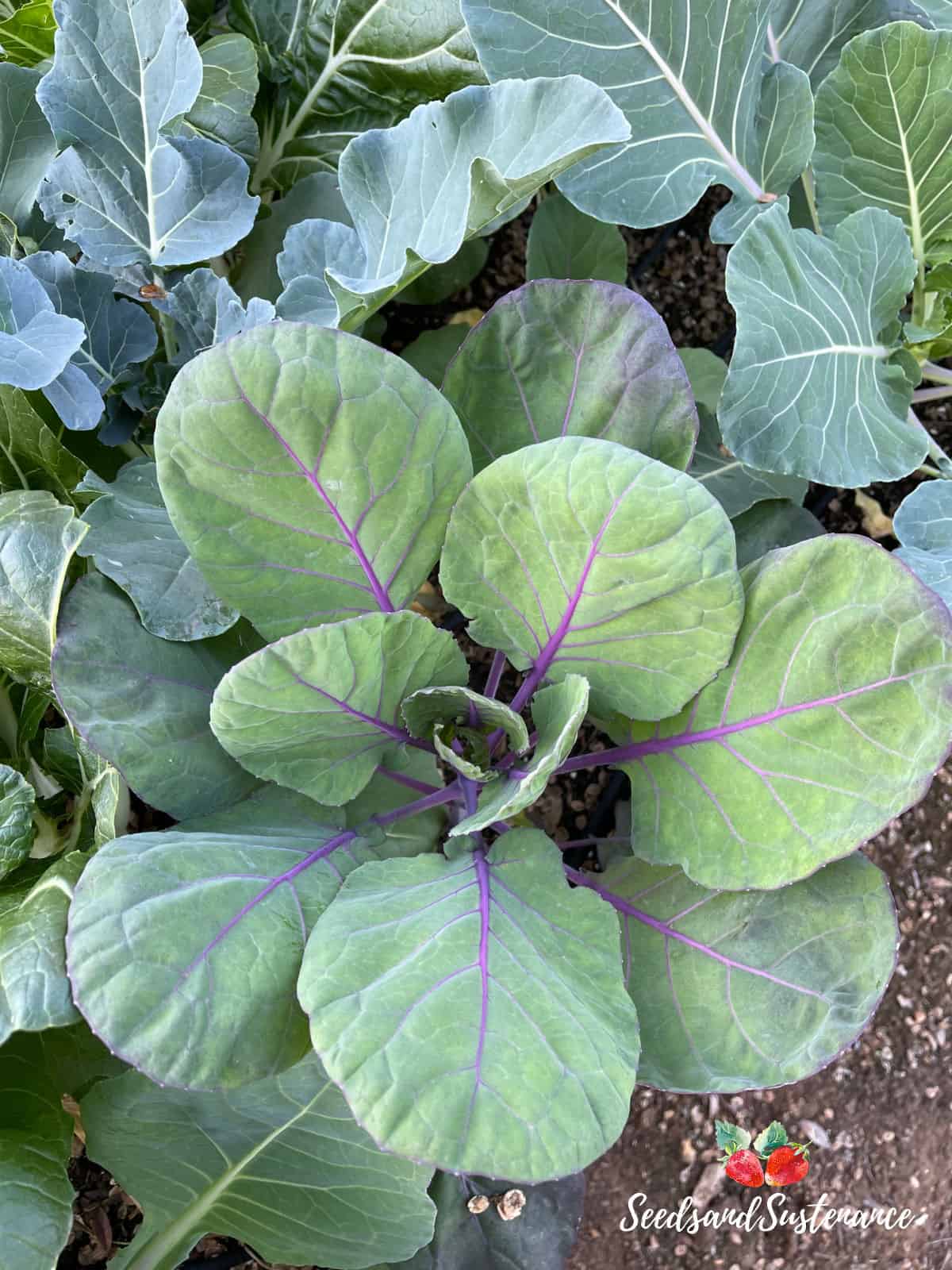
8. Use Neem Oil to Control Cabbage Worms
Neem oil is an amazing tool to have on hand in the garden. It's a plant-based oil extracted from the seed kernels of the neem tree.
Neem oil contains some very potent properties that soft-bodied insects like aphids, mealybugs, scale, spider mites, thrips, and white flies detest. It's also very good at deterring flying insects like mosquitos, moths, and flies.
Spraying neem oil on your garden veggies will make them less desirable to female cabbage moths and should help prevent female butterflies from laying eggs on treated areas.
However, neem oil will not kill caterpillars that are already on your plants. Use it as a way to encourage adult females to look elsewhere for a host plant.
You can get neem oil for cabbage worms HERE.
9. Make Decoy Moths to Place Around the Garden
This tip had me raising an eyebrow, but evidently, it works pretty well!
Cabbage moths are territorial and will avoid areas where other cabbage moths are present.
You can emulate this scenario but printing out a cabbage moth template and placing them around your cruciferous vegetables.
You can get the template for printing your own cabbage moths HERE.
10. How to Use Diatomaceous Earth for Cabbage Worms
Diatomaceous earth (DE) is an effective and natural way to eliminate cabbage worms. DE works by cutting through the waxy outer layer of the insect's body, which causes them to dehydrate and die.
To use diatomaceous earth on cabbage worms, add some of the powder to a dry sprayer and gently pump it on your brassicas. Make sure the powder gets into the crevices of your plants where the cabbage worms like to hide. Reapply DE every few days until the infestation is under control.
You can also dust DE directly on the cabbage worms to dehydrate them, but it's often more effective to pick off the caterpillars by hand.
Keep in mind that diatomaceous earth is harmful to humans and pets when inhaled, so wear a dust mask when applying it and keep children and animals away from treated areas.
DE is also harmful to bees, ladybugs, and other beneficial insects so you must use it with care and only in treatment areas.
With proper use, diatomaceous earth is an effective way to eradicate cabbage worms organically.
Frequently Asked Questions About Cabbage Worms
Will soapy water kill cabbage worms?
Yes, soapy water can kill cabbage worms. The soap disrupts the protective layer of wax on the insect's body, causing it to dehydrate and die. In addition to killing them on contact, this also has a long-term effect as it makes their environment uninhabitable for future generations.
So, if you have a problem with cabbage worms in the garden, be sure to use soapy water as a way to control them organically.
To use it, dilute a tablespoon of castile soap in a gallon sprayer with water. Then, spray your brassicas with the soapy solution once every 5-7 days.
How do I keep cabbage worms out of my garden?
The best way to keep cabbage worms out of your garden is by introducing their natural enemies, such as ladybugs, lacewings, and parasitic wasps. You can purchase these beneficial insects from your local nursery or garden center.
Another method is to use row covers to create a barrier between your cabbage and the pests. Row covers are lightweight mesh fabrics that can be draped over your plants to protect them from insect damage.
Additionally, practicing polycultural planting can help reduce cabbageworm damage. Planting Mexican marigolds around your cabbage plants will help repel pests, while garlic and chives can also be helpful for deterring pests.
Finally, applying BTK (bacillus thuringiensis kurstaki) is another effective organic solution for reducing cabbage worm population in your garden. This naturally occurring bacteria is harmless to humans and other beneficial insects, but deadly to cabbage worms.
You can find BTK at your local garden center or online.
Will vinegar get rid of cabbage worms?
The short answer is no, vinegar will not get rid of cabbage worms. Vinegar may help deter the pests from your plants, but it won't eliminate them completely. For a more effective solution, you should use natural predators like ladybugs and lacewings or an organic insecticide like BtK (bacillus thuringiensis var. kurstaki).
Will dish soap kill cabbage worms?
Yes, but you shouldn't use dish soap in the garden as it is too harsh on your plants and the surrounding environment. Instead, opt for more natural alternatives like castile soap.
Will salt water kill cabbage worms?
Yes, it can kill the caterpillars, but it will also kill the plants in your garden while also contaminating the soil. This will prevent future crops from thriving.
Can flour kill cabbage worms?
Actually, it can! Dust the plants where caterpillars are present on a sunny day. When the caterpillars eat the flour along with the leaves, they quickly become dehydrated and dry out. They are also unable to digest the flour, so even if they don't die from dehydration, they will die from not being able to process the flour.
Use white flour for the best results. You can also use fine cornmeal.
What do you spray on cabbage worms?
You can spray cabbage worms with soapy water made with castile soap. However, they are much more effective ways to eradicate cabbage worms outlined above.
How to get rid of cabbage worms?
The best and most natural way to get rid of cabbage worms is to introduce their natural enemies, such as ladybugs, lacewings, and parasitic wasps. You can purchase these beneficial insects from your local nursery or garden center.
Additionally, companion planting with Mexican marigolds, garlic, and chives around your cabbage plants may help repel pests.
Another option is to use Bt (bacillus thuringiensis), a naturally occurring bacteria that is harmless to humans and other beneficial insects but lethal to cabbage worms.
Finally, you can hand-pick them off your plants as soon as you see them. Put on a pair of gloves and pull the worms off your plants and toss them in a bucket of soapy water.
This method is usually effective in getting rid of cabbage worms before they do too much damage. With the right tools and techniques, you can easily control these pests organically and protect your precious cabbage crop from further damage.
What will kill cabbage worms?
Bt spray, flour and cornmeal sprinkles on your brassicas, DE (use carefully), soapy water made with castile soap, and natural predators.
Will baking soda get rid of cabbage worms?
Yes, if mixed in equal parts with white flour or fine cornmeal. You can sprinkle this mixture on your plants. The caterpillars will ingest it and die.
What is the best pesticide for cabbage worms?
As far as natural solutions, I recommend Bt spray or Spinosad - an insecticide based on chemical compounds found in the bacterial species Saccharopolyspora spinosa. This compound affects the caterpillar's nervous system, and it will die in a day or two. You spray either of these options on your brassicas about once a week if you have an infestation.
What plants get rid of cabbage worms?
There aren't any plants that get rid of cabbageworms, per see, but neem oil, which is made from the seed kernels of the neem tree, works as an excellent deterrent. You can also interplant your garden beds with various herbs like thyme, oregano, chives, lavender, and peppermint to ward off adult butterflies. They won't want to lay eggs where too many of these companion plants are present.
If you already have cabbage worms in the garden, these methods won't be all that effective.
What plants repel cabbage moths?
Aromatic herbs and other plants like thyme, parsley, rosemary, lavender, oregano, tansy, yarrow, marigold, chives, chamomile, garlic, and peppermint. Many of these will easily take over your garden beds, especially peppermint, so make sure you plant them in self-contained pots and dot them around your beds to keep them under control.
Do marigolds repel cabbage worms?
Yes, marigolds can help repel cabbage worms. Planting Mexican marigolds around your cabbage plants will help keep these pests away, as the strong scent produced by marigold flowers acts as a natural deterrent.
Do cabbage worms overwinter?
Yes, they can, but not in really cold climates. Cabbage worms particularly like plant debris along the margins and borders of your garden and will form a chrysalis to overwinter until warmer weather returns. Keeping these areas clean and tidy will help limit their options.
Does anything eat cabbage worms?
cabbage worms have several natural enemies:
- Beetles
- Birds - also chicken and other fowl
- Lacewings
- Ladybugs
- Parasitic flies
- Prasitic wasps
- Spiders
You may also enjoy reading:



Leave a Reply